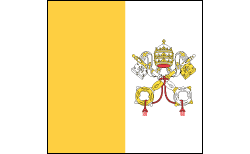Vatican City (Holy See)
 Ruler: Benedict XVI (2005) Land area: 0.17 sq mi (0.44 sq km) Population (July 2003 est.): 911; density per sq mi: 5,362 Monetary unit: Euro Languages: Italian, Latin, French, various other languages Ethnicity/race: Italian, Swiss, other Religion: Roman Catholic. Labor force: dignitaries, priests, nuns, guards, and 3,000 lay workers who live outside the Vatican. Budget (2001): Revenues: $173.5 million; expenditures: $176.6 million, including capital expenditures. Communications: Telephones: main lines in use: n.a.; mobile cellular: n.a. Radio broadcast stations: AM 3, FM 4, shortwave 2 (1998). Radios: n.a. Television broadcast stations: 1 (1996). Televisions: n.a. Transportation: Railways: total: 0.86 km; note: connects to Italy's network at Rome's Saint Peter's station (2001). Highways: none; all city streets. Ports and harbors: none. Airports: none. Heliports: 1 (2002). International disputes: none. |
Geography
The Vatican City State is situated on the Vatican hill, on the right bank of the Tiber River, within the city of Rome.
Government
The pope has full legal, executive, and judicial powers. Executive power over the area is in the hands of a commission of cardinals appointed by the pope. The College of Cardinals is the pope's chief advisory body, and upon his death the cardinals elect his successor for life.
History
The Vatican City State, sovereign and independent, is the survivor of the papal states that in 1859 comprised an area of some 17,000 sq mi (44,030 sq km). During the struggle for Italian unification, from 1860 to 1870, most of this area became part of Italy. By an Italian law of May 13, 1871, the temporal power of the pope was abrogated, and the territory of the papacy was confined to the Vatican and Lateran palaces and the villa of Castel Gandolfo. The popes consistently refused to recognize this arrangement. The Lateran Treaty of Feb. 11, 1929, between the Vatican and the kingdom of Italy, established the autonomy of the Holy See.
The first session of Ecumenical Council Vatican II was opened by John XXIII on Oct. 11, 1962, to plan and set policies for the modernization of the Roman Catholic Church. Pope Paul VI continued the council, presiding over the last three sessions. Vatican II, as it is called, revolutionized some of the church's practices. Power was decentralized, giving bishops a larger role, the liturgy was vernacularized, and laymen were given a larger part in church affairs.
On Aug. 26, 1978, Cardinal Albino Luciani was chosen by the College of Cardinals to succeed Paul VI, who had died of a heart attack on Aug. 6. The new pope took the name John Paul I. Only 34 days after his election, John Paul I died of a heart attack, ending the shortest reign in 373 years. On Oct. 16, Cardinal Karol Wojtyla, 58, was chosen pope and took the name John Paul II. Pope John Paul II became the first Polish pope and the first non-Italian pope since the 16th century.
On May 13, 1981, a Turkish terrorist shot the pope in St. Peter's Square, the first assassination attempt against the pontiff in modern times. The pope later met and forgave him. On June 3, 1985, the Vatican and Italy ratified a new church-state treaty, known as a concordat, replacing the Lateran Treaty of 1929. The new accord affirmed the independence of Vatican City but ended a number of privileges that the Catholic Church had in Italy, including its status as the state religion.
On April 2, 2005, John Paul died. He was the third-longest reigning pope (26 years). A champion of the poor, he is credited by many with hastening the fall of Communism in Poland and other eastern bloc countries. His vitality and charisma energized the world's 1 billion Catholics. His rule was characterized by conservatism regarding church doctrine, particularly on issues such as birth control, women's roles in the church, and homosexuality. The pope also remained circumspect about the U.S. church's sexual abuse scandals in 2002. He was the Vatican's greatest ambassador, traveling to 129 countries. John Paul canonized 482 saints and beatified 1,338 people, which was believed to be more than all his predecessors combined.
On April 19, German cardinal Joseph Ratzinger was named the new pope. Pope Benedict XVI is known as an accomplished scholar of theology and is considered an archconservative in his religious views. He served as Pope John Paul II's closest associate and is expected to continue the policy of a “strong Rome.” In Sept. 2006, Pope Benedict XVI apologized after angering Muslims around the world by quoting medieval passages that referred to Islam as “evil and inhuman.”
Hiç yorum yok:
Yorum Gönder